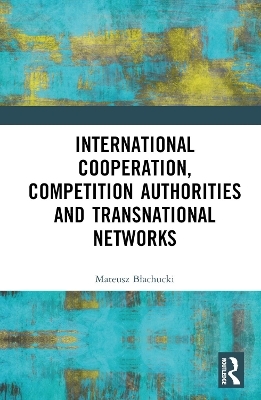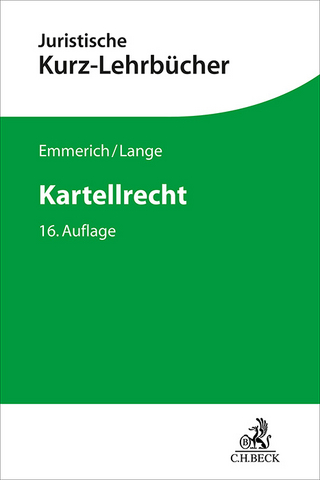
International Cooperation, Competition Authorities and Transnational Networks
Routledge (Verlag)
978-1-032-44624-0 (ISBN)
This book presents a comprehensive study of the emergence, functioning and evolution of international cooperation among competition authorities. It presents an in-depth look at network cooperation taking place within international organisations, as well as networks based on binding international agreements and various informal networks, among others. It further identifies and analyses the forms of international cooperation among national competition authorities (NCAs) that are taking place within transnational competition networks. The book classifies these forms of cooperation by grouping them into three stages – soft, developed and enhanced cooperation – discussing each in detail. It thus reflects the evolution of the international cooperation process and provides insights as to its possible development. This work will be of interest to researchers, academics and advanced students in the fields of competition law, public administration, international relations and those interested in international competition law and its contribution to global public governance.
Mateusz Błachucki is an Associate Professor at the Department of Administrative Law of the Institute of Law Studies of the Polish Academy of Sciences, where he specialises in competition law, transnational administrative law and administrative procedures. He serves as an adviser to the President of the Office for Competition and Consumer Protection (the Polish NCA) and is an expert in working groups devoted to competition protection and cooperation in various international networks: the International Competition Network, the European Competition Network, European Competition Authorities and the Organisation for Economic Co-operation and Development Competition Committee.
List of tables
List of Abbreviations
Table of Legislation
List of cases
1 Introduction
1.1 Transnational competition networks and international cooperation of national competition authorities
1.2 The subject of this book
1.3 Methods and materials
1.4 Structure of the book
1.5 Terminological notes
1.6 Bibliographical annotations
1.7 Repository of source documents
Acknowledgements
2 The concept and kinds of transnational competition networks
2.1 The concept of a network as an organisational structure
2.2 The concept of a network for legal purposes
2.3 The concept of a transnational competition network
2.4 Types of transnational competition networks
2.4.1 The scope and purpose of network activities
2.4.2 Relations among network members
2.4.3 Placing networks in existing institutional treaty structures
2.4.4 Formalising the initiation and operation of networks
2.4.5 Territorial range of network activity
2.4.6 Network membership
2.5 Concluding remarks
3 Global competition networks
3.1 Organisation for Economic Co-operation and Development
3.1.1 Origin and history
3.1.2 Legal basis
3.1.3 Network aims
3.1.4 Membership
3.1.5 Internal organisation
3.1.6 Internal organisational units for cooperation in competition protection
3.1.7 Forms of activity
3.1.8 Network output
3.1.9 Form and scope of cooperation
3.1.10 Network characteristics: summary
3.2 United Nations Conference on Trade and Development
3.2.1 Origin and history
3.2.2 Legal basis
3.2.3 Network aims
3.2.4 Membership
3.2.5 Internal organisation
3.2.6 Internal organisational units for cooperation in competition protection
3.2.7 Forms of activity
3.2.8 Network output
3.2.9 Form and scope of cooperation
3.2.10 Network characteristics: summary
3.3 World Trade Organization
3.3.1 Origin and history
3.3.2 Legal basis
3.3.3 Network aims
3.3.4 Membership
3.3.5 Internal organisation
3.3.6 Internal organisational units for cooperation in competition protection
3.3.7 Forms of activity
3.3.8 Network output
3.3.9 Form and scope of cooperation
3.3.10 Network characteristics: summary
3.4 International Competition Network
3.4.1 Origins and history
3.4.2 Legal basis
3.4.3 Network aims
3.4.4 Membership
3.4.5 Internal organisation
3.4.6 Forms of activity
3.4.7 Network output
3.4.8 Form and scope of cooperation
3.4.9 Network characteristics: summary
3.5 Concluding remarks
4 Continental competition networks
4.1 Europe
4.1.1 European Economic Area
4.1.1.1 European Competition Authorities
4.1.1.1.1 Origin and history
4.1.1.1.2 Legal basis
4.1.1.1.3 Network aims
4.1.1.1.4 Membership
4.1.1.1.5 Internal organisation
4.1.1.1.6 Forms of activity
4.1.1.1.7 Network output
4.1.1.1.8 Forms and scope of cooperation
4.1.1.1.9 Network characteristics: summary
4.1.2 European Union
4.1.2.1 European Competition Network
4.1.2.1.1 Origin and history
4.1.2.1.2 Legal basis
4.1.2.1.3 Network aims
4.1.2.1.4 Membership
4.1.2.1.5 Internal organisation
4.1.2.1.6 Forms of activity
4.1.2.1.7 Network output
4.1.2.1.8 Forms and scope of cooperation
4.1.2.1.9 Network characteristics: Summary
4.1.2.2 Eu merger working group
4.1.2.2.1 Origin and history
4.1.2.2.2 Legal basis
4.1.2.2.3 Network aims
4.1.2.2.4 Membership
4.1.2.2.5 Internal organisation
4.1.2.2.6 Forms of activity
4.1.2.2.7 Network output
4.1.2.2.8 Forms and scope of cooperation
4.1.2.2.9 Network characteristics: summary
4.2 African Competition Forum
4.2.1 Origin and history
4.2.2 Legal basis
4.2.3 Network aims
4.2.4 Membership
4.2.5 Internal organisation
4.2.6 Forms of activity
4.2.7 Network output
4.2.8 Forms and scope of cooperation
4.2.9 Network characteristics: summary
4.3 Asia-Pacific Economic Cooperation
4.3.1 Origin and history
4.3.2 Legal basis
4.3.3 Network aims
4.3.4 Membership
4.3.5 Internal organisation
4.3.6 Internal organisational units committed to cooperation on competition protection
4.3.7 Forms of activity
4.3.8 Network output
4.3.9 Forms and scope of cooperation
4.3.10 Network characteristics: summary
4.4 Other continental and sub-global networks
4.5 Concluding remarks
5 Regional competition networks
5.1 Europe
5.1.1 Nordic Cooperation
5.1.1.1 Origin and history
5.1.1.2 Legal basis
5.1.1.3 Network aims
5.1.1.4 Membership
5.1.1.5 Internal organisation
5.1.1.6 Forms of activity
5.1.1.7 Network output
5.1.1.8 Forms and scope of cooperation
5.1.1.9 Network characteristics: summary
5.1.2 Marchfeld Competition Forum
5.1.2.1 Origin and history
5.1.2.2 Legal basis
5.1.2.3 Network aims
5.1.2.4 Membership
5.1.2.5 Internal organisation
5.1.2.6 Forms of activity
5.1.2.7 Network output
5.1.2.8 Forms and scope of cooperation
5.1.2.9 Network characteristics: summary
5.1.3 Central European Competition Initiative
5.1.3.1 Origin and history
5.1.3.2 Legal basis
5.1.3.3 Network aims
5.1.3.4 Membership
5.1.3.5 Internal organisation
5.1.3.6 Forms of activity
5.1.3.7 Network output
5.1.3.8 Forms and scope of cooperation
5.1.3.9 Network characteristics: summary
5.1.4 Interstate Council for Anti-monopoly Policy
5.1.4.1 Origin and history
5.1.4.2 Legal basis
5.1.4.3 Network aims
5.1.4.4 Membership
5.1.4.5 Internal organisation
5.1.4.6 Forms of activity
5.1.4.7 Network output
5.1.4.8 Forms and scope of cooperation
5.1.4.9 Network characteristics: summary
5.2 Africa and the Middle East
5.2.1 West African Monetary Union
5.2.1.1 Origin and history
5.2.1.2 The legal basis for WAEMU’s activities
5.2.1.3 Network objectives
5.2.1.4 Membership
5.2.1.5 Internal organisation
5.2.1.6 Internal organisational units committed to cooperation on competition protection
5.2.1.7 Forms of activity
5.2.1.8 Network output
5.2.1.9 Forms and scope of cooperation
5.2.1.10 Network characteristics: summary
5.2.2 Arab Competition Network
5.2.2.1 Origin and history
5.2.2.2 Legal basis
5.2.2.3 Network aims
5.2.2.4 Membership
5.2.2.5 Internal organisation
5.2.2.6 Forms of activity
5.2.2.7 Network output
5.2.2.8 Forms and scope of cooperation
5.2.2.9 Network characteristics: summary
5.3 Asia
5.3.1 Association of Southeast Asian Nations
5.3.1.1 Origin and history
5.3.1.2 Legal basis
5.3.1.3 Network aims
5.3.1.4 Membership
5.3.1.5 Internal organisation
5.3.1.6 Internal organisational units committed to cooperation on competition protection
5.3.1.7 Forms of activity
5.3.1.8 Network output
5.3.1.9 Forms and scope of cooperation
5.3.1.10 Network characteristics: summary
5.4 South America
5.4.1 Andean Community
5.4.1.1 Origin and history
5.4.1.2 Legal basis
5.4.1.3 Network aims
5.4.1.4 Membership
5.4.1.5 Internal organisation
5.4.1.6 Internal organisational units committed to cooperation on competition protection
5.4.1.7 Forms of activity
5.4.1.8 Network output
5.4.1.9 Forms and scope of cooperation
5.4.1.10 Network characteristics: summary
5.4.2 Red Centroamericana de Autoridades Nacionales Encargadas del Tema de Competencia
5.4.2.1 Origin and history
5.4.2.2 Legal basis
5.4.2.3 Network aims
5.4.2.4 Membership
5.4.2.5 Internal organisation
5.4.2.6 Forms of activity
5.4.2.7 Network output
5.4.2.8 Forms and scope of cooperation
5.4.2.9 Network characteristics: summary
5.5 Other regional competition networks
5.6 Concluding remarks
6 Soft forms of international cooperation of competition authorities within networks
6.1 Establishing contact and exchanging experiences
6.2 Cooperation connected with establishing legislative aims and standards, and coordinating administrative practice (soft law)
6.3 Verification of compliance with common standards on the part of network members
6.4 Concluding remarks
7 Developed forms of international cooperation of competition authorities within networks
7.1 International cooperation of NCAs that does not affect the rights or obligations of the parties or other participants to the competition proceedings
7.1.1 Establishing contact points for international cooperation
7.1.2 Informing foreign NCAs about the initiation of proceedings
7.1.3 Exchanging unclassified information concerning proceedings and other information that is not subject to legal protection
7.1.4 Reporting on administrative actions in another jurisdiction
7.1.5 Informal assistance among network members
7.2 Administrative acts under international cooperation affecting the rights and obligations of parties and participants in competition proceedings
7.2.1 Exchange of protected information and evidence
7.2.2 Mutual assistance
7.2.3 Refraining from or suspending or discontinuing proceedings
7.2.4 Coordination and reconciliation of administrative actions by NCAs
7.2.5 Coordination and reconciliation of administrative decisions of NCAs
7.2.6 Allocation of cases between national and transnational competition authorities
7.3 Concluding remarks
8 Enhanced competition-related international cooperation within transnational networks
8.1 Introduction of a one-stop shop model (eg, for leniency applications or markers)
8.2 Designation of a lead national jurisdiction for transnational cases
8.3 Staff cooperation and the establishment of joint investigation teams or the cross-appointment of officials from different NCAs to investigation teams
8.4 Settlement of disputes concerning international cooperation between NCAs
8.5 Mutual recognition of administrative acts and court decisions in competition matters
8.6 Binding an NCA to a decision of a foreign or transnational competition authority
8.7 Judicial cooperation in competition matters
8.8 Cooperation between parliaments
8.9 Concluding remarks
9 Supervision of the international activities of national competition authorities within networks
9.1 The impact of international cooperation of NCAs on the rights of parties and other participants to proceedings
9.2 Forms of supervision of the international activities of NCAs within TCNs
9.2.1 Hierarchical administrative supervision of the international activities of the Polish NCA
9.2.2 Supervision exercised by the Ombudsman and the Public Prosecutor
9.2.3 Supervision exercised by special independent public authorities
9.2.4 Supervision exercised by the European Commission
9.2.5 Judicial control of the transnational activities of NCAs
9.2.6 Jurisdiction of national courts in relation to the supervision of the international activities of the Polish NCA
9.2.7 Jurisdiction of transnational and international courts in relation to supervising the international activities of the Polish NCA
9.2.8 Parliamentary control in relation to the supervision of the international activities of the Polish NCA
9.2.9 Social control of public administration in Poland
9.3 Concluding remarks
10 Perspectives on the development of transnational competition networks
10.1 TCNs and the alternative resources available for transnational cooperation of NCAs
10.2 The reasons that underlie the success of TCNs and the prospects for their further development
10.3 The strengths and weaknesses of TCNs
10.4 TCNs as a ‘necessary evil’ for NCAs
10.5 TCNs and the convergence and harmonisation of law and administrative practice
10.6 Concluding remarks
11 Conclusions
Index
| Erscheinungsdatum | 05.12.2023 |
|---|---|
| Zusatzinfo | 11 Tables, black and white |
| Verlagsort | London |
| Sprache | englisch |
| Maße | 156 x 234 mm |
| Gewicht | 707 g |
| Themenwelt | Recht / Steuern ► Allgemeines / Lexika |
| Recht / Steuern ► EU / Internationales Recht | |
| Recht / Steuern ► Wirtschaftsrecht ► Wettbewerbsrecht | |
| Wirtschaft ► Volkswirtschaftslehre ► Makroökonomie | |
| ISBN-10 | 1-032-44624-2 / 1032446242 |
| ISBN-13 | 978-1-032-44624-0 / 9781032446240 |
| Zustand | Neuware |
| Haben Sie eine Frage zum Produkt? |
aus dem Bereich


